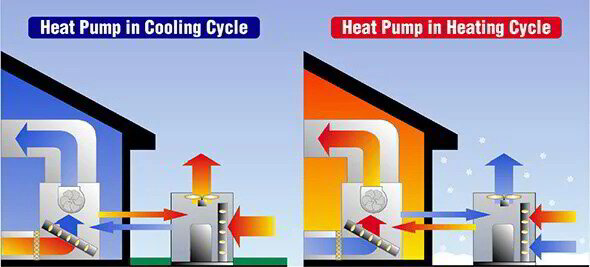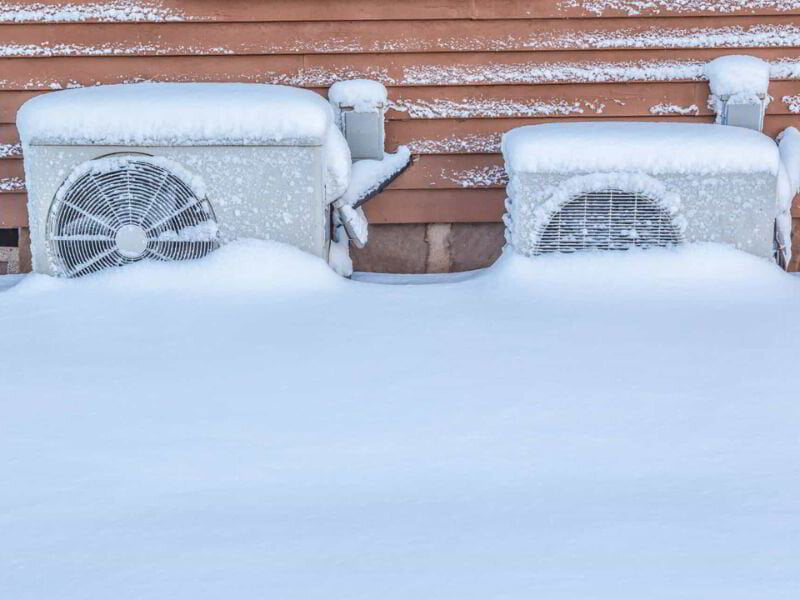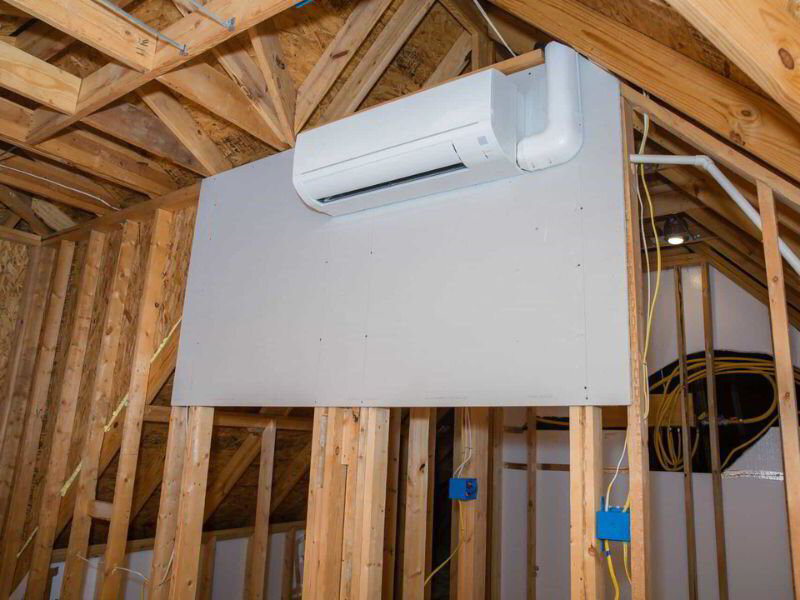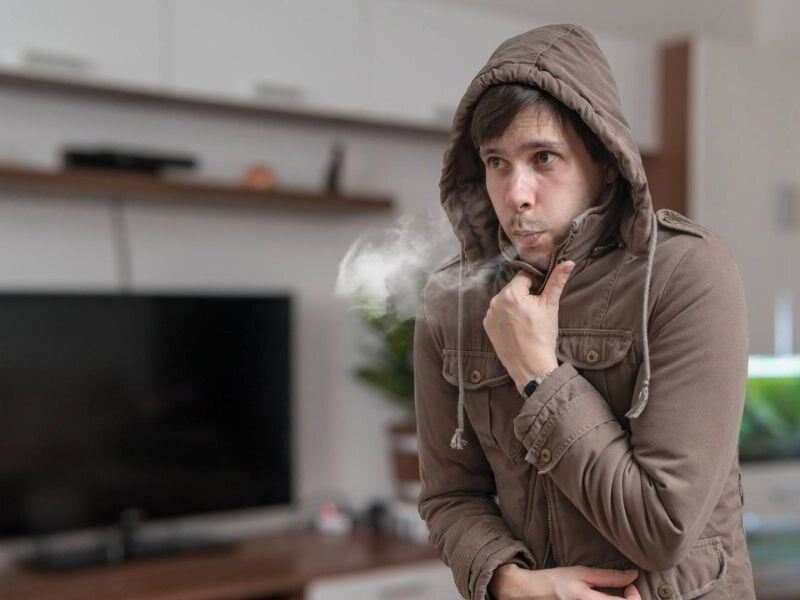As the US continues to be hit by unprecedently heavy winters, it’s more important than ever to have reliable heating.
For those who rely on heat pumps as their heat source, this raises a very important question: at what temperature do heat pumps stop working?
Typically, most heat pumps will stop working when temperatures drop below 25°F. But at the same time, some models can continue to run at sub-zero temperatures.
We’ll explain how heat pumps work and why your model might be struggling with freezing temperatures (if it’s your model at all).
Blog Table of Contents
How Heat Pumps Work

A heat pump works quite differently from your traditional furnace.
And it’s not because it’s also an air conditioner.
Natural gas furnaces, alongside most other furnaces, work by burning fuel to create heat.
While this typically works fine, it’s inefficient and requires large amounts of fuel or electricity.
Instead, heat pumps use energy transfer to heat homes.
Heat transfer is accomplished using a substance in the heat pump called refrigerant.
This substance is constantly heated and cooled using electrical components, which allow it to absorb heat from the outdoor air and release it into the home.
Because the heat pump doesn’t produce heat but instead just transfers it, it’s a lot more energy efficient than furnaces.
While this makes it great for lowering heating costs in moderate weather, it can start to run into problems when the outside temperature drops.
At What Temperature Is a Heat Pump Not Effective?

When there’s less heat energy in the air, it’s more difficult for the heat pump to extract heat and bring it into the home.
So in very cold weather, you can expect reduced performance from your heat pump.
Eventually, any heat pump will be unable to keep extracting enough heat to warm the home suitably and will need assistance from a backup heating system.
However, the point at which this happens varies significantly depending on the model.
Standard heat pumps will begin to lose efficiency rapidly once the temperature drops below 40°F.
If the temperature drops below 25°F, there will be minimal heating capacity, and the backup heating systems need to turn on.
Two kinds of heat pumps fare much better in cold weather than the traditional styles. These are cold-climate air source and mini-split heat pumps.
Mini-split Heat Pumps

Mini-split heat pumps work exactly the same way as regular heat pumps: they extract heat from the outside with an outdoor unit and bring it inside.
However, their method of distribution is different.
Traditional heat pump systems use ductwork to transfer heat around the home. Mini-splits, on the other hand, are ductless heat pumps.
Instead, they transfer heat using refrigerant lines to the indoor air handling units.
This allows mini-split heat pumps to work in much lower temperatures while remaining highly energy efficient.
Many mini-splits can continue to run at full efficiency as low as 10°F and can continue to provide heat in negative temperatures.
Cold Climate Air Source Heat Pumps
Cold climate air source heat pumps, also known as a cold climate heat pump, are also an effective heating solution in cold temperatures.
Unlike traditional systems, this heat pump is designed specifically for people living in cold climates.
As the name suggests, an air source heat pump extracts heat from the outside air.
This type of heat pump dramatically increases the heat pump efficiency, which allows for more efficient heating in cold weather.
As a result, this heat pump works in temperatures as low as -20°F.
Alternative Reasons Your Heat Pump Isn’t Heating

Often, it’s not the model itself which is causing the heating problems.
Issues with the system’s components or installation can make your heat pump ineffective when outdoor temperatures drop.
Here are a few common scenarios for heat pump owners:
Bad Insulation
Your heat pump might be struggling to warm your home because the heat it’s producing is being lost by the insulation.
Without insulation, there almost wouldn’t be any difference between being inside and outside your home.
It’s only because there’s insulation installed in the frame of your house that heat stays in, and cold temperatures are kept out.
Insulation can similarly affect the heat produced by heat pumps.
If the insulation is poor, the warm temperature heat pumps produce will quickly escape from your home through air leaks.
You should check your insulation to ensure there aren’t any holes or spots where air could leak. You should also ensure the insulation’s r-value fits your home’s size and climate.
Undersized or Oversized Heat Pump
Heat pumps are individually designed for different environments and spaces.
If you end up installing a heat pump that isn’t the right size for your home, this can lead to inefficient heating.
The problem with having an undersized heat pump is pretty apparent.
If your heat pump is too small, it will struggle to provide enough heat for your home in normal circumstances.
When cold temperatures demand increased performance, this will worsen the situation.
An oversized heat pump will produce more heat than necessary to keep your house warm.
This leads to a phenomenon called short cycling, where the system keeps turning off and back on again, which causes unreliable heating.
To find the right size heating system for your home, you’ll need first to calculate the square footage of your home.
For every square foot of your home, you’ll need around 30 BTU (British Thermal Units) of power in your heat pump.
Older Heat Pump Systems
Having up-to-date heat pump technology is important for maintaining your indoor temperature.
Due to wear and tear sustained over years of operation, older heat pumps already work much less effectively.
You can expect greatly reduced performance or breakdown when you add low temperatures into the mix.
Thanks to technological advancements, modern heat pumps also provide much more energy-efficient heating output.
This makes them cheaper to run and more reliable when there’s little heat available in the outdoor temperature.
If you’ve owned your heat pump system for more than 10 years and regularly need to pay for repairs, it’s likely time to get a replacement.
Thermostat Problems
A faulty thermostat controlling your heat pump can easily lead to heating problems.
A thermostat manages your standard heat pump.
This thermostat controls the heating process and ensures the heat is equally distributed throughout the home.
Problems with your thermostat can lead to the heating turning off before it’s meant to, making it seem like the heat pump has stopped working.
Additionally, the thermostat could actually be working but just set to a certain temperature that it shouldn’t be.
You should check that your thermostat is set to the right temperature and is operating as it should be.
You may also be able to turn on your backup heating system from the thermostat, which can help you deal with extreme cold emergencies.
Final Thoughts
There’s no one-size-fits-all answer to at what temperature do heat pumps stop working.
But after having read this article, you should at least understand how heat pumps work and what can cause them to stop working efficiently.
If your heat pump system regularly fails in the cold and needs to be repaired, you should contact Upstate Home Maintenance Services.
Upstate Home Maintenance Services offer the most experienced heat pump repair and installation in Spartanburg and Greenville County, SC.
Let us help you avoid the dangers of cold weather by booking an appointment today.
We also offer comprehensive services for heating and cooling systems, from the classic natural gas furnace to ultramodern HVAC systems.
No matter the problem, we have the skills to fix it.
This article was written by Morgan Loch
Owner of Upstate Home Maintenance Services LLC and Local HVAC Guru


